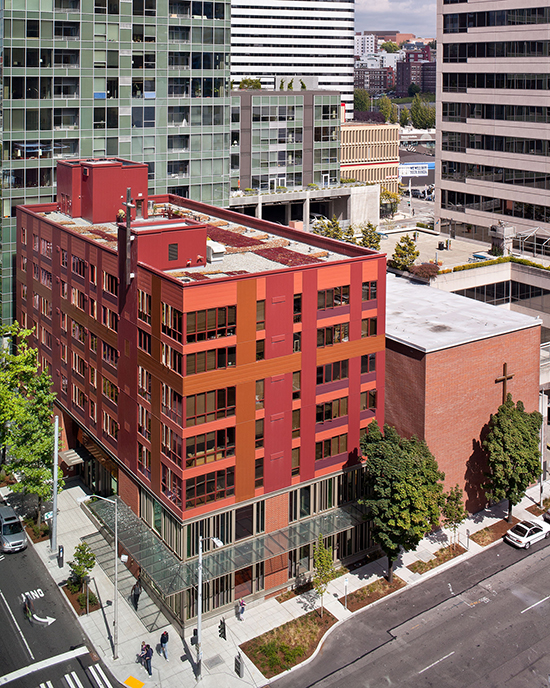|
Subscribe / Renew |
|
|
Contact Us |
|
| ► Subscribe to our Free Weekly Newsletter | |
| home | Welcome, sign in or click here to subscribe. | login |
Construction
| |
 |
May 2, 2013
Mixed-Use Construction
Gethsemane Church/Dekko Place Apartments
Rafn Co.
Architect (Gethsemane): Olson Kundig Architects
Architect (Dekko Place): SMR Architects
(Editor's note: The architects' roles previously were switched.)Engineer (Gethsemane and Dekko): Coughlin Porter Lundeen
Owner (Gethsemane):Gethsemane Lutheran Church
Owner (Dekko Place): Compass Housing Alliance
ABC members: Adept Mechanical Services; Clark Nuber; Custom Sprinkler; Evergreen Concrete Cutting; Kirby Electric; Propel Insurance
Rafn Co. earned the Mixed-Use Construction award for its reconstruction of Gethsemane Lutheran Church, a 1950s-era sanctuary at the corner of Stewart Street and Ninth Avenue, and for the construction of the 50-unit Dekko Apartments adjacent to the church.
The Dekko Apartments were developed by the Compass Housing Alliance as affordable housing for low-income residents. The church’s side of the building includes spaces for Gethsemane’s ministries and the Church of Mary Magdalene. The lower level houses the new Hope Center offering community services, meal programs and 9,000 square feet of space for Mary’s Place Day Center, a day shelter for homeless women and children.
The ability to impact a project’s cost and functional capability is at its greatest in the concept phase and then diminishes as the project moves through design and construction. The Rafn team was brought in during the pre-construction phase to find value in places such as the shoring and earth work, structural systems, MEP and skin systems, fenestration and other work — all while keeping an eye on the impacts to sequencing, logistics and costs.
Because of this early investigative involvement, Rafn was able to save $20,000 in design, $150,000 in construction costs and two months in the schedule by re-using existing foundations as temporary shoring. The team also decided to install hydronic in-floor heating throughout in lieu of wall units since the cost was not that much more, but the performance was significantly better. Plus, Rafn came up with a plan to integrate old and new mechanical systems.
Perhaps the biggest challenge for Rafn was working with two separate owners with separate goals. Rafn addressed this challenge by staffing the project with two superintendents, which saved time on the schedule and allowed the company to focus on the disparate needs of the clients.
An ongoing challenge was the allocation of costs between multiple uses and owners. For instance, two different wage rates required subcontractors to sign in separately for each phase and charge costs to the correct phase even though their work overlapped phases.
Given the challenges of integrating two very separate structures by the two separate architects, many of the design decisions did not come until the work was well underway.
One example of this was the storefront/art glass mounting. The owner had a vision for a gorgeous facade at the street level that had to be balanced with the reality of its structural implications to the building. Rafn brought in Pacific Glazing Systems, who solved the problem by dividing the glass design and installation into two systems.
Once the storefront side was in, other trades were able to move ahead with their finish work in the climate-controlled interior of the building while the glass sub shifted focus to the art glass installation.
The project was built to the Evergreen Sustainable Development Standard and Built Smart — certified through the use of low-energy lighting and fans, low-flow showers and toilets, and high-efficiency hot water boilers. The building has radiant floor heating, occupancy sensors in common areas, low-VOC paints, high U-value windows and a roof-top garden that doubles as an urban oasis.
Rafn was able to recycle concrete from the demolition of the existing building. For the project, it recycled more than 90 percent by separating concrete, wood, cardboard and non-recyclable items in the construction waste stream.
The complex project required 38,270 labor hours and with Rafn’s stringent safety program, including site safety orientations, safety audits and weekly meetings, there were only two medical-only and one time-loss incidents on the job.
Other Stories:
- Safety's role in the ‘new normal’ of construction
- Health Care
- Commercial Construction
- Survey: Andersen Construction
- Demolition
- Specialty Construction (merit award)
- Survey: S.D. Deacon
- Survey: Lease Crutcher Lewis
- Survey: Skanska USA
- Survey: Express Construction Co.
- Survey: PCL Construction Services
- Electrical & Communications
- Mechanical Construction
- Institutional
- ‘Big Room’ streamlines collaboration, communication
- Technology moves construction projects off the paper trail
- Going modular? Think of the factory as a big subcontractor
- Sharp equipment managers use decision points
- Sick leave, pot laws leave employers feeling queasy
- Making sense of construction cost audits
- Is your insurance broker a claims advocate?
- Avoid the pitfalls of transition planning
- Eagle of Excellence Award • Tenant Improvement/Renovation
- Eagle of Merit Award • Specialty Construction
- Survey: Rider Levett Bucknall



